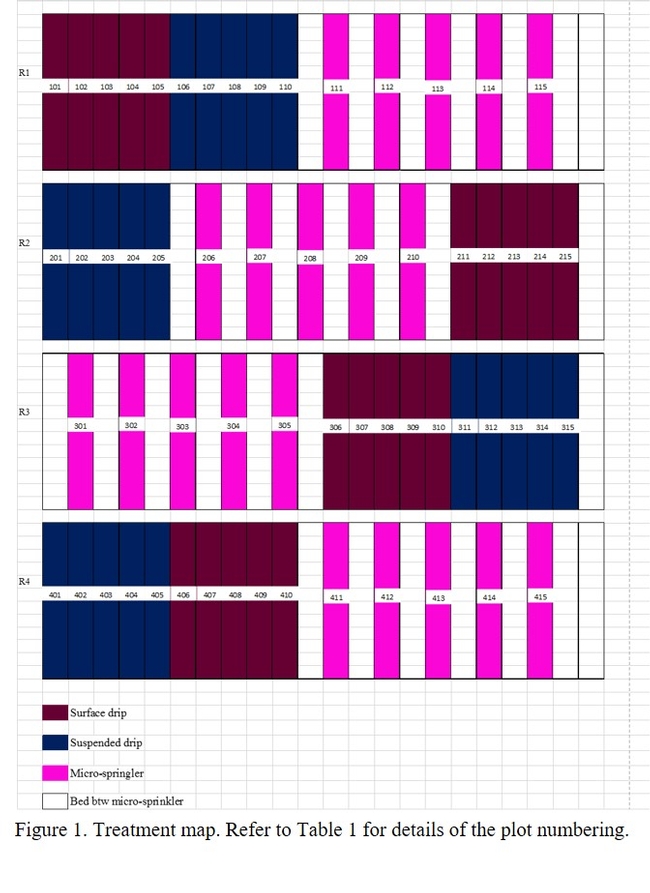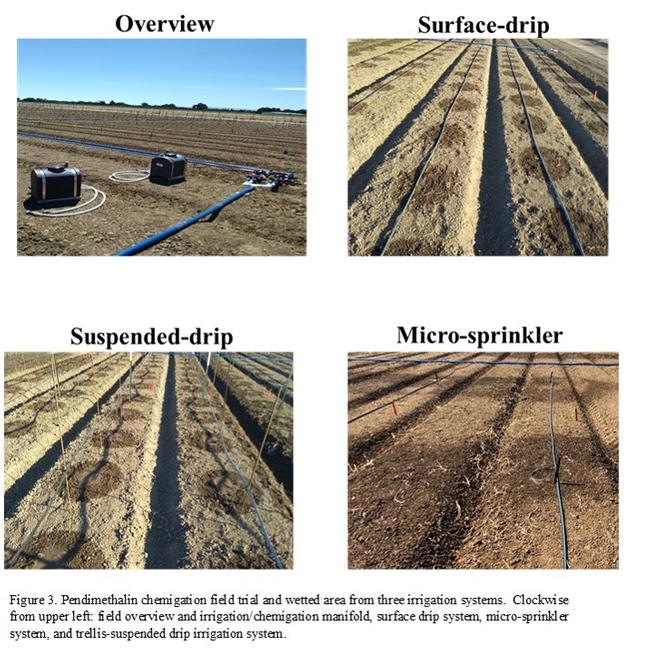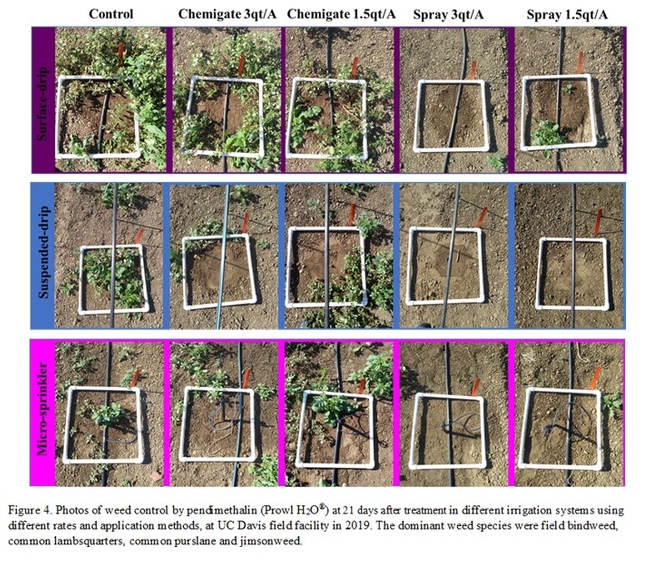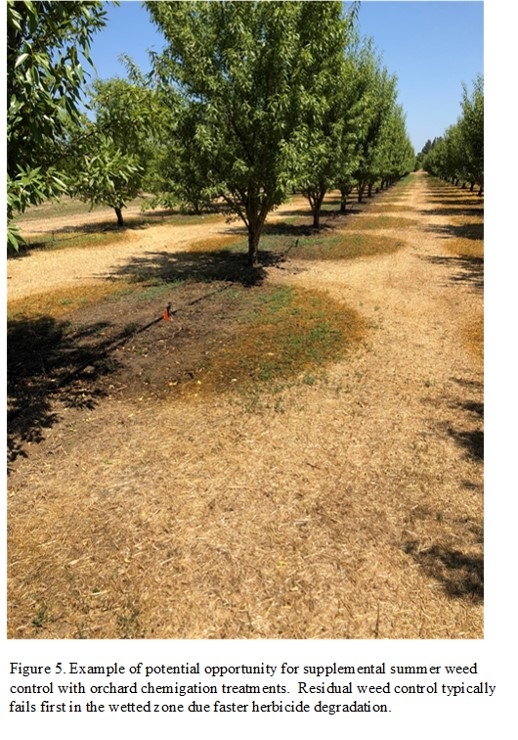This article was originally prepared for the CWSS Research Update and News (December 2019 edition). You can see it and several other articles at the CWSS website. You can also get information on the annual California Weed Science Society Conference which will be held in Monterey during January 22-24, 2020.
Brad
Performance of Pendimethalin (Prowl H2O ®) in Different Irrigation Systems used in Orchards and Vineyards. Adewale Osipitan1, John Roncoroni2,and Bradley D. Hanson1 (1Department of Plant Sciences, University of California, Davis, CA and 2UC Cooperative Extension, Napa, CA).
Preemergence herbicides typically are applied in orchard and vineyard production systems as a “strip spray” using a tractor-mounted our pull-behind sprayer to spray a few feet on either side of each tree or vine row. Compared to agronomic crops where large spray booms and higher application speed acre commonly used, operator time and equipment hours represent a greater proportion of the per-acre cost of chemical weed control in orchard and vineyard crops. A few herbicides registered in California tree and vine crops allow application via the irrigation system (chemigation). This low-cost herbicide application technique could be useful in some situations, particularly as part of a sequential program for season-long weed control. However, little information is available on how to most effectively use herbicide chemigation in orchards and vineyards and how weed control efficacy compares to standard application techniques.
An initial preliminary experiment was conducted in summer 2019, at the UC Davis Plant Sciences Field Facility to compare the relative performance of pendimethalin (Prowl H2O®) applied through spraying or chemigation in surface-drip, suspended-drip and micro-sprinkler irrigation systems common in California permanent crops. The experiment was laid out in a randomized complete block design with a split-plot arrangement (Table1; Figure 1). 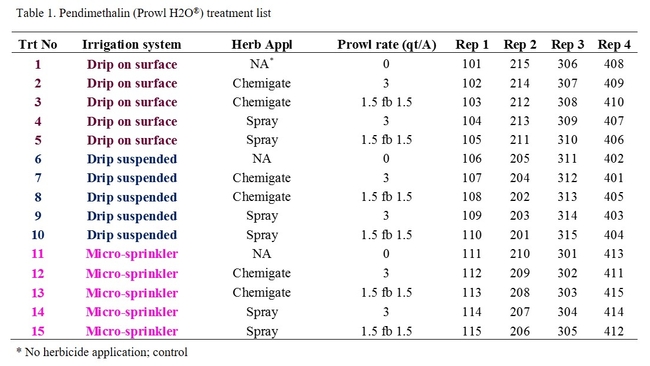
The main plot treatments were three irrigation systems designed to mimic orchard micro-sprinkler and drip systems or a vineyard irrigation system suspended above the ground from the trellis. The sub-plot treatments were combinations of pendimethalin application method (spray or chemigation) and rates in four replications (Table 1; Figure 1). Each sub-plot was 50ft long and 5ft wide and herbicide rates were calculated based on the visible wetted area on the soil surface. The sub-plots within the micro-sprinkler main plots were separated by 5ft to prevent overlapping of treatments. The irrigation was initiated on July 23, with subsequent irrigation on July 24, 27 and 29 that ensured up to 15 inches depth of moist soil, sufficient to promote weed growth.
The drip systems have eleven 1 GPH emitters per sub-plot while the micro-sprinkler system has two 19 GPH emitters per sub-plot. The emitters in the suspended-drip system were about 2 ft above the soil surface. Herbicide treatments were applied on July 30 (Table 2). The spray treatments were applied with a CO2 pressurized backpack sprayer calibrated to deliver 20 GPA at 35 PSI through two TeeJet TTI11002 flat fan nozzles and incorporated with the main plot irrigation system. The chemigation treatments injected into the field distribution manifold and applied in the plots through 1 GPH emitter (drip treatments) or 19 GPH (micro-sprinkler treatments). The herbicide injection period was about 20 minutes and irrigation continued for an additional 40 minutes after application to flush lines and incorporate the herbicide. Subsequently, plots were irrigated for 2 hrs twice per week. A second application of pendimethalin was made on August 23 (24 days after first application), to complete the 1.5 qt/A split application (Table 1) and this application followed the same process described above. Weed control data were collected 14, 24, and 45 days after first application of pendimethalin. For visual weed control assessment, 0 represents no visible control of weeds and 100 represents complete absence of weeds within 0.25 m2 quadrant. The dominant weeds in the research field were broadleaves, including field bindweed (Convolvulus arvensis L.), common lambsquarters (Chenopodium album L.), common purslane (Portulaca oleracea L.) and jimsonweed (Datura stramonium L.).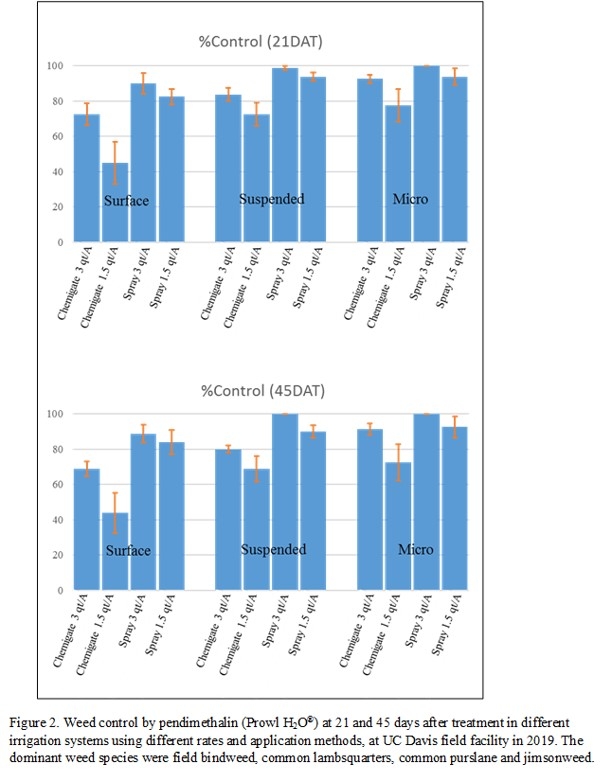
Because the experiment was conducted in late summer in a fallowed annual crop field, weed pressure was primarily small-seeded summer broadleaf weeds and field bindweed. Pendimethalin treatments controlled these weeds 45-100% at 45 days after treatment (Figure 2). In general, weed control with conventionally-sprayed plots was greater than through chemigation even though incorporation was less than ideal. Of the chemigated plots, the micro-sprinkler irrigation system allowed a broader control of weeds with pendimethalin, presumably due to better distribution uniformity (Figure 3). The suspended drip system was slightly better than the surface drip system (Figure 2 and 4). Within the 45 day time period evaluated a single application of pendimethalin at 3 qt/A provided greater weed control, than the split application at 1.5 qt/A, particularly when applied through chemigation (Figure 2 and 4).
In spite of the modest level of summer broadleaf weed control from these applications as a stand-alone approach, there appears to be some potential fit for chemigation in California orchard and vineyard crops as part of a herbicide program. In particular, a relatively low rate of pendimethalin applied via the irrigation system in the spring might provide substantial supplemental weed control in the immediate area wetted by the irrigation system (Figure 5) where dissipation of the foundation herbicide would be greatest. Additionally, the chemigation approach may also have some fit as part of the sequential herbicide approaches we have evaluated in recent years for control of glyphosate-resistant summer grasses. (link1, link2, link3)
This 2019 pilot experiment will be repeated in 2020 at an early spring timing more appropriate for supplemental control of summer weeds in orchard and vineyard production systems.
